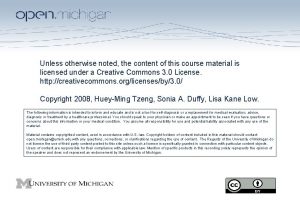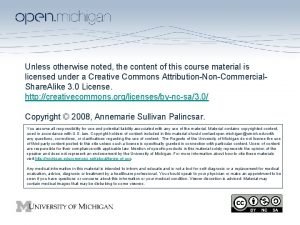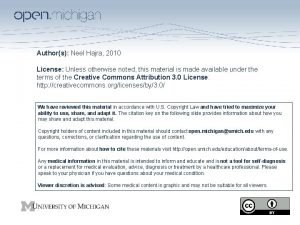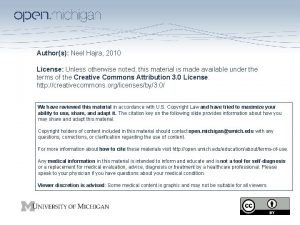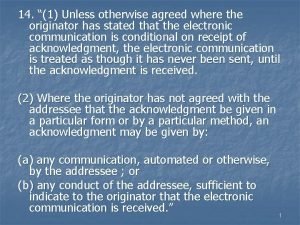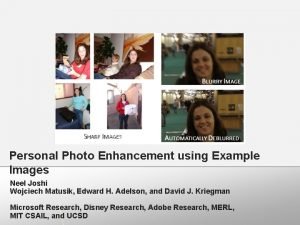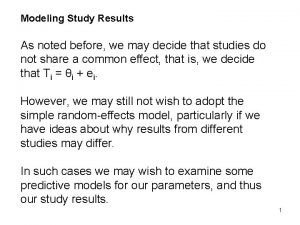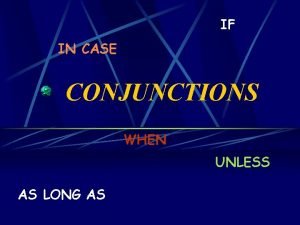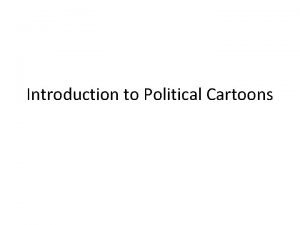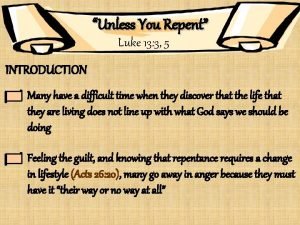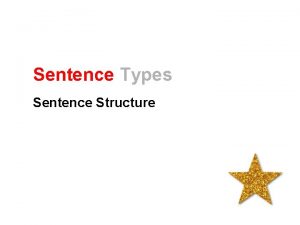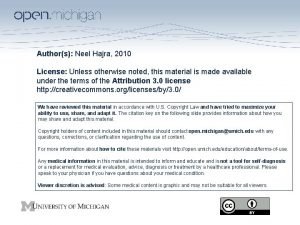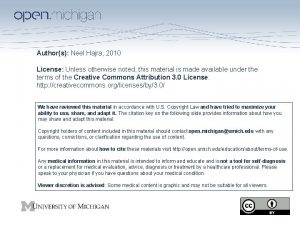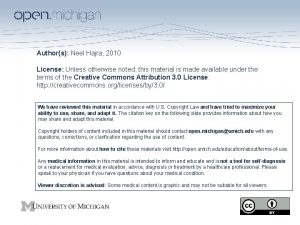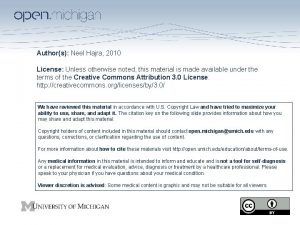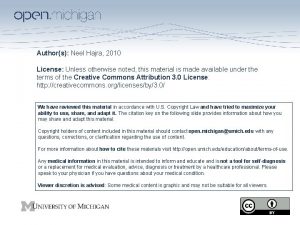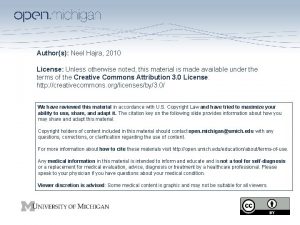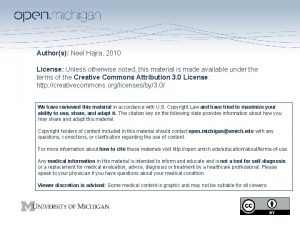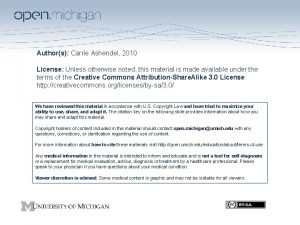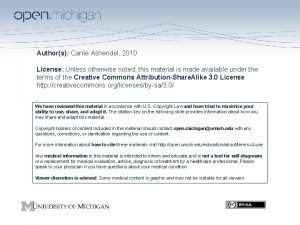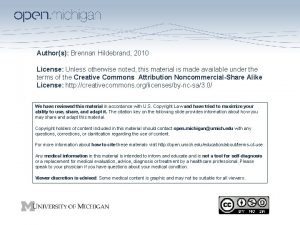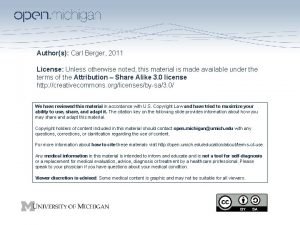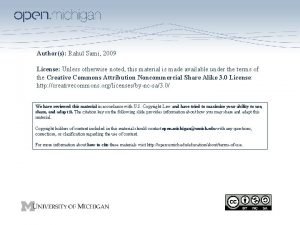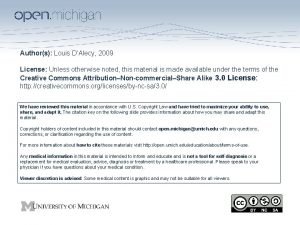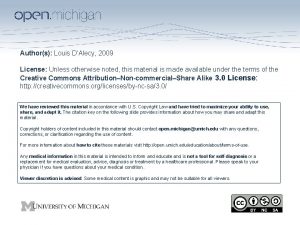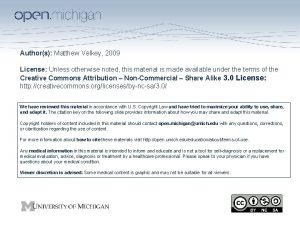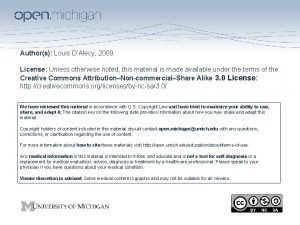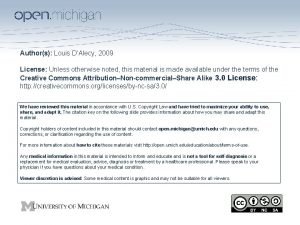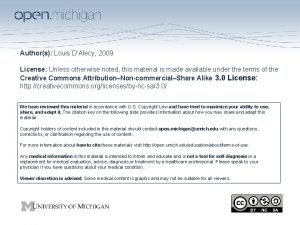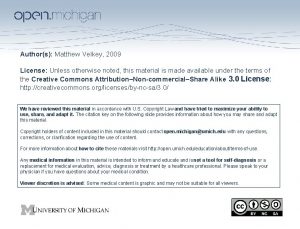Authors Neel Hajra 2010 License Unless otherwise noted






































- Slides: 38

Author(s): Neel Hajra, 2010 License: Unless otherwise noted, this material is made available under the terms of the Creative Commons Attribution 3. 0 License: http: //creativecommons. org/licenses/by/3. 0/ We have reviewed this material in accordance with U. S. Copyright Law and have tried to maximize your ability to use, share, and adapt it. The citation key on the following slide provides information about how you may share and adapt this material. Copyright holders of content included in this material should contact open. michigan@umich. edu with any questions, corrections, or clarification regarding the use of content. For more information about how to cite these materials visit http: //open. umich. edu/education/about/terms-of-use. Any medical information in this material is intended to inform and educate and is not a tool for self-diagnosis or a replacement for medical evaluation, advice, diagnosis or treatment by a healthcare professional. Please speak to your physician if you have questions about your medical condition. Viewer discretion is advised: Some medical content is graphic and may not be suitable for all viewers.

Citation Key for more information see: http: //open. umich. edu/wiki/Citation. Policy Use + Share + Adapt { Content the copyright holder, author, or law permits you to use, share and adapt. } Public Domain – Government: Works that are produced by the U. S. Government. (USC 17 § 105) Public Domain – Expired: Works that are no longer protected due to an expired copyright term. Public Domain – Self Dedicated: Works that a copyright holder has dedicated to the public domain. Creative Commons – Zero Waiver Creative Commons – Attribution License Creative Commons – Attribution Share Alike License Creative Commons – Attribution Noncommercial Share Alike License GNU – Free Documentation License Make Your Own Assessment { Content Open. Michigan believes can be used, shared, and adapted because it is ineligible for copyright. } Public Domain – Ineligible: Works that are ineligible for copyright protection in the U. S. (USC 17 § 102(b)) *laws in your jurisdiction may differ { Content Open. Michigan has used under a Fair Use determination. } Fair Use: Use of works that is determined to be Fair consistent with the U. S. Copyright Act. (USC 17 § 107) *laws in your jurisdiction may differ Our determination DOES NOT mean that all uses of this 3 rd-party content are Fair Uses and we DO NOT guarantee that your use of the content is Fair. To use this content you should do your own independent analysis to determine whether or not your use will be Fair.

Pub. Pol 671: Policy & Management in the Nonprofit Sector Lecture 10: Scaling Up Neel Hajra

Note – Characterizing Lobbying Costs OMB Circular A-122 (“Cost Principles for Nonprofit Organizations”): ◦ Circular allows for inclusion of some lobbying costs as “direct” expenses ◦ I will speak to some auditors to learn more…

Growth: Public Sector Pro’s? Con’s?

Growth: For-Profit Sector Pro’s? Con’s?

Growth: Nonprofit Sector Pro’s? Con’s?

Nonprofit Growth: “The Success Paradox” Double bottom line: Mission usually DRAINS resource So more mission = less resource!!

The experimentation principle If part of the role of the nonprofit sector is experimentation / innovation, then scaling is critical

What Can Be Grown? Organizational models Programs Principles

Why Grow? Mission / Impact Sustainability Legitimacy (feeds into first two)

Why Grow? : Impact Potential Benefits ◦ More service = more impact ◦ Larger org = higher capacity Potential Risks ◦ Getting distracted from mission ◦ Diluting original nexus of impact

Why Grow? : Funding Potential Benefits ◦ Larger ◦ More Potential Risks ◦ Potential loss of core funders! ◦ Can be harder to maintain sustainability

Why Grow? : Legitimacy Potential Benefits ◦ Fundraising ◦ For “place at the table” ◦ For validation of mission/vision Potential Risks ◦ Ego-driven decisions ◦ Does org size always = legitimate?

Models for Scaling Up Dissemination Affiliation Growth/Branching

Model: Dissemination Pro’s ◦ Relatively easy ◦ Relatively cheap ◦ Leverages web Con’s ◦ Control ◦ Revenue ◦ Impact (? )

Model: Affiliation (a. k. a. franchising) Pro’s ◦ Less central pressure ◦ Lower cost of expansion ◦ Leverage local goodwill/resources Con’s ◦ Control / Reliance on others ◦ Management and coordination ◦ Brand diffusion

Model: Growth/Branching Pro’s ◦ Control ◦ Leverage existing talent ◦ Economies of scale Con’s ◦ Expensive ◦ HR ◦ Competition

5 R’s - Readiness Efficient, proven, well-run? Understand key activities Strong theory of change ID potential constraints ID growth potential Infrastructure Talent Managing complexity (standardization)

5 R’s - Receptivity Market analysis! Allies Competitors CLASSIC PITFALL: What you’re told isn’t the always the same as reality

5 R’s - Resources Funders and stakeholders at both ends Invest in key areas of need Financial structure / business model CLASSIC PITFALL: Easy to underestimate resource needs

5 R’s - Risks Scenario planning Wind-down strategy Check-in points CLASSIC PITFALL: Easy to underestimate and under-investigate risks

5 R’s - Returns Financial? Mission? CLASSIC PITFALL: Assuming 1 +1 =2

Policy: Growth Is growth imperative? Should we favor or disfavor growth? Role of federal and state governments

Policy: Scale = Government? When is the public sector the best vehicle for large scale impact? How does that happen? What is your bias?

NEXT: STEPPINGSTONE

Why Grow Steppingstone? Greater Impact Employee Retention and “Vibrancy” Other considerations: ◦ Funding ◦ Legitimacy

Whether to Grow Steppingstone? Market Analysis: 675 potential scholars! Market Analysis: Space at high quality schools

Challenges of Growing Steppingstone Maintaining quality Growing program staff Developing true management team (and moving beyond “steering clear of thunderstorms and avoiding ice”) Growing facilities I. T. H. R. processes Cost: $15. 6 million over 5 years!

Steppingstone Pitfalls Marketing staff ◦ Marketing function ◦ “Strategic” function ◦ Different mindset!

Steppingstone Keys to Success Good model, recognition of key activities Fundraising Infrastructure Planning, planning!!

Steppingstone Today From 2008 Annual Report: “Nearly doubled the scholars served in Boston, to 900” Expanded to Philadelphia and Hartford Started the National Partnership for Education Access

NEXT: KABOOM!

Unspoken Benefit of KABOOM!’s Open Source Model Fundraising!

NEXT: Youth. Build

“Full Scale” and Cost? 50, 000 students/year (6 x increase) in 850 communities (4 x increase) Federal: $1 billion annual (17 x increase) States/Local: $250 annual (current level unstated) Establish $85 million growth fund

Elements of Growth Fund Federal and state advocacy Quality assurance Innovation Research on program impact Strengthen management capacity to handle growth Strategic grants to local programs.

Public-Private Scaling Partnershi Rona Proudfoot, Wikimedia Commons “…the federal government acts as the ocean liner that manages the taxpayers’ funds, and we are the flexible tugboat that can move quickly to correct mistakes, support innovation, and maintain inspiration at the grass roots. ” Stoneman, Stanford Social Innovation Review
 Unless otherwise noted meaning
Unless otherwise noted meaning Unless otherwise noted meaning
Unless otherwise noted meaning Unless noted otherwise
Unless noted otherwise Excecro
Excecro Neel hajra
Neel hajra Unless otherwise agreed
Unless otherwise agreed Dr robert neel
Dr robert neel Neel order
Neel order Mst
Mst Difference between curie temperature and neel temperature
Difference between curie temperature and neel temperature Philip neel
Philip neel Neel bhalala
Neel bhalala Difference between curie temperature and neel temperature
Difference between curie temperature and neel temperature Ferromagneti
Ferromagneti Neel sachdev
Neel sachdev Neel rattan halder
Neel rattan halder Neel joshi md
Neel joshi md Example of objective reality
Example of objective reality Nigel barker age
Nigel barker age Noted
Noted In case unless
In case unless Unless what
Unless what The trust giant's point of view
The trust giant's point of view You usually do your homework at night
You usually do your homework at night Sandy feels dirty unless she bathes and changes
Sandy feels dirty unless she bathes and changes The part can never be well unless the whole is well meaning
The part can never be well unless the whole is well meaning Unless lisp
Unless lisp A unless b
A unless b Lisp cond
Lisp cond Juliet threatens to kill herself unless the friar
Juliet threatens to kill herself unless the friar Unless you repent you will all likewise perish
Unless you repent you will all likewise perish Unless you repent
Unless you repent Poetic devices for an elementary school classroom in a slum
Poetic devices for an elementary school classroom in a slum The weather has been nice but it may snow again any day
The weather has been nice but it may snow again any day Oraciones unimembres
Oraciones unimembres Unless
Unless Dissociative disorder not otherwise specified
Dissociative disorder not otherwise specified Lifting inserts which are embedded or otherwise
Lifting inserts which are embedded or otherwise Dissociation disorder
Dissociation disorder
